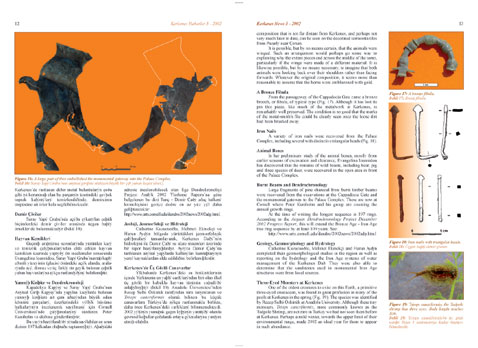FINDS
A Bronze Fibula
From
the passageway of the Cappadocia Gate came a bronze brooch,
or fibula, of typical type (Fig.
17). Although it has lost its pin this piece, like much
of the metalwork at Kerkenes, is remarkably well preserved.
The condition is so good that the marks of the metal-smith's
file could be clearly seen once the loose dirt had been brushed
away.
Iron Nails
A
variety of iron nails were recovered from the Palace Complex,
including several with distinctive triangular heads (Fig.
18).
Animal Bones
In
her preliminary study of the animal bones, mostly from earlier
seasons of excavation and clearance, Evangelina Ioannidou has
discovered that the remains of wild beasts, including bear,
pig and three species of deer, were recovered in the open area
in front of the Palace Complex.
Burnt Beams and Dendrochronology
Large
fragments of pine charcoal from burnt timber beams were recovered
from the excavations at the Cappadocia Gate and the monumental
gateway to the Palace Complex. These are now at Cornell where
Peter Kuniholm and his group are counting the annual growth
rings.
At
the time of writing the longest sequence is 197 rings. According
to the Aegean Dendrochronology Project December 2002 Progress
Report, this will extend the Bronze Age - Iron Age tree ring
sequence by at least 100 years. See:
http://www.arts.cornell.edu/dendro/2002news/2002adp.html
Geology, Geomorphology
and Hydrology
Catherine
Kuzucuoglu, Mehmet Ekmekçi and Harun Aydin completed
their geomorphological studies in the region as well as reporting
on the hydrology and the Iron Age systems of water management
of the Kerkenes Dag. They were also able to determine that the
sandstones used in monumental Iron Age structures were from
local sources.
Three-Eyed Monsters
at Kerkenes
One
of the oldest creatures to exist on this Earth, a primitive
three-eyed crustacean, was found in great profusion in many
of the pools at Kerkenes in the spring (Fig.
19). The species was identified by Recep Sulhi Özkütük
at Anadolu University. Although these tiny monsters, Triops
cancriformis, more commonly known as the Tadpole Shrimp, are
not rare in Turkey we had not seen them before at Kerkenes.
Perhaps a mild winter, towards the upper limit of their environmental
range, made 2002 an ideal year for them to appear in such abundance.



